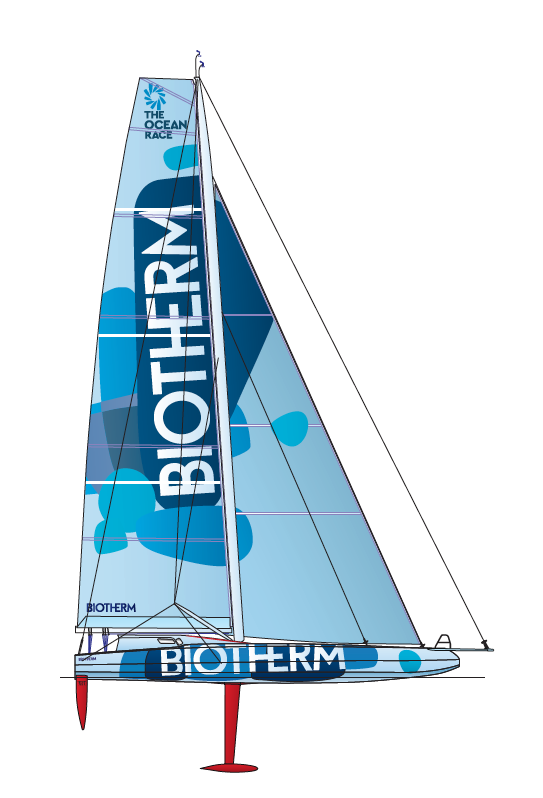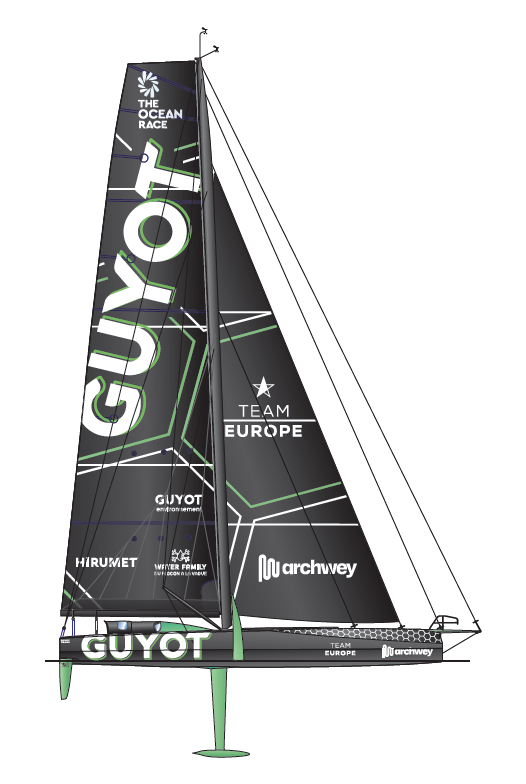1 - Des Maxi des années 1970 aux premiers W60
2 – Des Volvo 60 aux Volvo 70
3 – du Volvo 65 aux IMOCA
DEUXIÈME PARTIE :
Des Volvo 60 au Volvo 70
 |
| EF Language Sail plan © F Chevalier |
Pour l’édition 1997-98, la Whitbread Round The World Race se dispute avec les W60, et le score se décompte en points, au lieu de temps additionné au long des étapes, qui sont au nombre de neuf. Dix concurrents quittent Southampton pour ce tour du monde dont la dernière étape passe par La Rochelle. Bruce Farr signe 8 des 10 plans, et s’octroie les sept premières places, et la neuvième, avec l’équipage féminin mené par Christine Guillou. Paul Cayard, célèbre régatier, remporte la victoire sur EF Language devant un chiffre impressionnant de figures de la course, comme Dennis Conner, Chris Dickson, Laurie Smith, Grant Dalton, Ross Field ou John Kostecki. Les plans Farr sont tous très proches, avec des formes encore assez rondes par rapport aux précédents Maxi.
 |
| EF Language Perspective © F Chevalier |
Déjà sponsorisé par Volvo en 1997-98, la Whitbread suivante change de nom et devient la 2001-02 Volvo Ocean Race.
La nouvelle jauge qui définit les VO 60 autorise le gréement carbone, ce qui va booster ces voiliers et modifier profondément leur comportement. Sur les huit candidats à la victoire, six plans conçus par Farr Design prennent le départ. L’équipe du Nautor Challenge a fait construire deux bateaux, dont un signé Bruce Farr, Amer Sport Two, l’autre, Amer Sport One, étant de la main de German Frers, Jr., « Mani Frers ». Le skipper Grant Dalton a réservé son choix jusqu’au dernier moment, laissant le yacht de Farr à l’équipage féminin de Lisa McDonald. Enfin, le huitième est le Norvégien Djuice Dragons, imaginé par Laurie Davidson.
Ce qui frappe en regardant les trois dessins, c’est d’une part l’étroitesse de la flottaison des voiliers, et d’autre part, le creux assez prononcé des carènes. Les trois concepteurs ont en effet créé des coques minces, munies de ballasts le plus à l’extérieur possible, avec un petit bouchain arrondi, jauge oblige, au niveau du maître-bau.
 |
| Illbruck Challenge lines © F Chevalier |
Pour Farr, un bateau doit être une « luge » coupée conformément aux exigences de la jauge. La coque semble sculptée à la serpe : l’avant est taillé en pointe selon un plan incliné suivant un tracé de pont rectiligne de l’étrave jusqu’au mât. Suit une seconde coupe verticale sur 50 cm et parallèle sur chaque bord. Celle-ci se prolonge loin sur l’arrière. Enfin, l’ultime taille intervient sur les flancs, à 45° vers le bas de la quille au point de mesure de la chaîne. Elle se poursuit sans artifice jusqu’au tableau arrière.
 |
| Djuice Dragons lines © F Chevalier |
Laurie Davidson a privilégié la sécurité et créé une forte réserve de flottaison sur l’avant, pénalisée par une grande surface développée. Le voile de quille de Djuice semble important par rapport aux autres.
 |
| Mani Frers' Amers Sport One lines © F Chevalier |
Le dessin de Mani Frers montre une plus grande raideur, avec des flancs moins évasés que ceux de ses concurrents, et une étrave plus rasante. Son voile de quille, légèrement en avant du mât, favorise les allures de près, mais rend le racer plus volage aux allures portantes. Son plan de voilure et très reculé, avec un mât proche du milieu.
Les bateaux de Farr remportent les deux premières places, Illbruck Challenge devant Assa Abloy, le tracé de Mani Frers est sur l’ultime marche du podium. Celui de Laurie Davidson se contente de la sixième position, avec une victoire dans la dernière étape.
 |
| Illbruck Challenge © F Chevalier |
Pour la 2005-06 Volvo Ocean Race, une nouvelle classe de voilier est introduite, le Volvo Open 70. Plus longs, relativement plus légers, plus toilés, avec des quilles basculantes et deux safrans possibles, ils héritent des progrès de l’America’s Cup comme ceux des TP52 ou des Open 60.
Juan Kouyoumdjian est le grand gagnant de l’épreuve, son ABN Amro One remporte 16 des 22 manches de cette course et son ABN Amro Two, skippé par Sébastien Josse, se place en quatrième position, établissant un nouveau record de vitesse sur les 24 heures. Les quatre VO 70 de Bruce Farr, Pirates of Caribbean, barré par Paul Cayard, Brasil, Ericsson et Movistar s’intercalent, et le voilier australien conçu par Don Jones, Brunel-Sunergy, termine dernier.
 |
| ABN Amor One's lines © F Chevalier |
Les plans de Juan exploitent au maximum la jauge, plus large, donc plus raide, étrave inversée et rasante, quille basculante, pivotant à l’intérieur de la coque, ce qui augmente encore la raideur au près, carène fuyante sur la moitié arrière, dérive profonde, quille allongée avec une section réduite. Plus puissantes et plus planantes, ces coques s’imposent et vont marquer les carènes à venir.
 |
| Movistar's lines © F Chevalier |
Bruce Farr a cherché la finesse et l’équilibre, avec un safran dans l’axe du voilier. Movistar perd sa quille, l’équipage est repêché par ABN Amro Two.
 |
| Brunel-Sunergy's lines ©F Chevalier |
Quant à Don Jones, mal servi par un budget réduit, il avait créé un voilier plus conventionnel, plus rond et large, des formes avant pleines, avec une dérive unique en avant d’un mât très avancé et un cockpit très reculé.
 |
| ABN Amro One Sail plan © F Chevalier |
La dixième édition de cette course autour du monde, la 2008-09 Volvo Ocean Race devient de plus en plus difficile à suivre pour le public. Elle part d’Espagne, passe par Le Cap, gagne Singapour, puis la Chine à Qingdao, traverse l’océan Pacifique du Nord au Sud, rejoint Rio et Boston, l’Irlande, Göteborg, Stockholm, et se termine à Saint-Pétersbourg en Russie ! On est très loin de la Whitbread en quatre étapes.
Sur les dix voiliers, Juan Kouyoumdjian en conçoit trois, Bruce Farr deux, le cabinet Botin Carkeek un, Reichel/Pugh un, et Roy Humphreys le dernier.
Ericsson 4, un plan JK, avec Torben Grael à la barre, domine la meute, suivi par Puma de Botin, mené par Ken Read, Telefonica Blue de Farr se place troisième.
Je n’ai pas eu l’occasion de finaliser les tracés que j’avais préparés pour l’édition de 2008-2009, aucun magazine n’ayant donné suite à ma proposition de publier les plans des cinq cabinets d’architecte.
 |
| Ericsson 4 sail plan © F Chevalier |
Pour 2011-2012, sur les trois architectes en lice, Juan K en imagine la moitié, le Français Groupama 4 barré par Franck Cammas, l’Américain Puma skippé par Ken Read, et l’Espagnol Telefonica, mené par Iker Martinez. Farr Yacht Design en a dessiné un, Abu Dhabi ; le Chinois Sanya est l’ex- Telefonica Blue, un plan Farr, skippé par le vainqueur de 2006, Mike Sanderson. Enfin, Marcelino Botin, remarquable pour ses TP52, est l’auteur des plans de Camper pour ETNZ.
 |
| Camper lines © F Chevalier |
De façon la plus surprenante pour cette « Box Rule », les plans des trois architectes s’avèrent totalement différents. Marcelino Botin a créé un véritable super TP52, fin, tendu à l’extrême, avec un centre de gravité très avancé, un bau reculé au trois-quarts de sa longueur et un tableau arrière rasant, des dérives immenses en arrière du mât, lui-même centré sur le milieu du voilier.
 |
| Abu Dhabi lines (Farr Yacht Design) © F Chevalier |
Le plan de Farr rompt avec toutes les tendances. Considérant que ces racers planent à partir de la moindre brise, et stoppent brutalement dans les vagues trop abruptes, la coque doit se mettre au planning le plus vite possible, et basculer au près sans trop pivoter sur l’avant, afin d’augmenter la raideur. Résultat, une étrave monumentale, ronde et pleine, rasante, des flancs verticaux, un bau maximum autorisé dès la moitié du voilier, une ligne de flottaison large et centrée, des formes tendues, mais douces, des dérives fines et élaborées, pratiquement verticales et proches de l’axe. Le pont est bombé vers l’étrave, sans marquage de roof.
 |
| Groupama 4 lines (by JK) ©F Chevalier |
Juan K a développé ses plans précédents en optimisant tous les avantages déjà acquis lors de la dernière édition remportée par le Suédois Ericsson. Des formes avant très élaborées, bien visibles sur les sections avant, sous un bouchain qui se poursuit jusqu’à la proue ; des fonds plats dès l’étrave, garantissant un départ au planning et écartant l’axe du voilier à la gîte pour une plus grande raideur ; des fonds arrière épousant la forme de la vague, afin de favoriser le prolongement du sillage et d’allonger la vague définissant la vitesse limite. Toutes ces caractéristiques ont démontré leurs avantages sur les autres concurrents.
Groupama 4 emporte le trophée Volvo sur le dessin Botin Camper, suivi par les deux nouveaux plans JK, Puma et Telefonica, les deux Farr terminant bons derniers.
 |
| Groupama 4 Sail plan ©F Chevalier |
 |
| Puma Sail plan ©F Chevalier |
Les six sections des deux V60 et des quatre V70 montrent bien l’évolution des formes des voiliers de cette période de la Whitbread. Entre le premier, le Laurie Davidson et le Mani Frers de 2001, la flottaison s’élargit.
Du premier V70 en haut à droite de Don Jones de 2006 jusqu’au Botin de 2011, le bouchain se précise et les formes se radicalisent.
2 sections de VO 60 et quatre de VO 70, entre 2001 et 2011 ©F Chevalier


















































